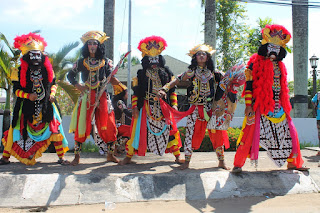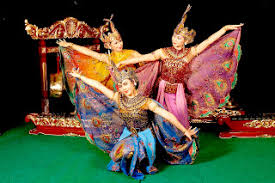Here are some traditional dances from West Java:
 1. Sintren Traditional Dance
1. Sintren Traditional Dance
Dance sintren is a dance that
comes from Cirebon. This dance smells mystical because it tells about the love
story of Sulasih and Sulandono. This dance is very mystical, even before this
dance is performed it must begin with duplication or a praying ritual. But
along with the times, this dance began to sink.
 2. Topeng Traditional Dance
2. Topeng Traditional Dance
Mask dance is a traditional dance that comes from Cirebon. In general, mask dancers use three masks that are used simultaneously. Beginning with a white-colored mask, then blue, and end with a red-colored mask. Each mask change, the accompanying music will get louder as a symbol of the character played by the character. Music accompaniment in mask dance is to use a typical gamelan Cirebon.
3. Merak Traditional Dance
Merak dance is a dance that originated from West Java. Named the peacock dance because this dance shows the beauty and beauty of a peacock's peacock. The peacock dance dancers use a costume that also resembles peacock feathers.
4. Wayang Traditional dance
Wayang dance is a dance that comes from Cirebon. Referred to as wayang dance because the dancers use costumes and perform movements such as wayang figures. Wayang dance can be played singly, in pairs or bulk. While the character played by the players consists of a variety of male and female characters.
5. Ketuk Tilu Traditional Dance
Ketuk Tilu dance is a dance that comes from Bogor and surrounding areas. Tapu tilu dance consists of female dancers commonly called ronggeng and nayaga as musical accompaniment.
Tap dance performances are usually performed in open areas or outside the room. Ronggeng will usually dance around a legged light. In the show the audience scramble to dance with their choice of ronggeng.
6. Jaipong Traditional Dance
Jaipong Dance is a traditional dance originating from West Java. This dance originally came from the dance of ketuk tilu. Jaipong is one of the creativity of artists of West Java Gugum Gembira. Currently jaipong dance has become one of the dance icons in West Java. This dance is widely performed at the event held by the community or government of West Java.
7. Buyung Traditional Dance
Buyung dance is a traditional dance originating from West Java. This dance is performed during the peak ceremony ceremony seren epidemic performed by the people of West Java.
This dance tells the village girls who are bathing and take water together in the waterfall Ciereng by using a jar or commonly called a pitcher.
8. Keurseus Traditional Dance
Keurseus dance is a dance originating from West Java. At first this dance was performed by officials. In the pronunciation of this sunda dance called keurseus dance, so that the dance taught in Wirahmasari is then known in the community with the name of dance keurseus.
9. Ronggeng Bugis Traditional Dance
Ronggeng bugis dance is a traditional dance that comes from Cirebon. This dance is comedic. Ronggeng bugis dance is usually done by male dancers as much as 12 - 20 people with makeup and style of dancing like women.
The origin of this dance, motivated by the tension that occurred between the kingdom of Cirebon with the Islamic kingdom. Sunan Gunung Jati as King of Cirebon then told a relative from the kingdom who came from the bugis tribe to oversee the kingdom of Padjadjaran. The musical instruments of this dance are the merriment, the kendang, the small gongs, and the kecrek.
10. Sampiung Traditional Dance
Sampiung dance is a dance that originated from West Java. This dance is performed for important day ceremonies such as harvest festivities, ngaruat, rebo wekasan, and seren epidemic, even state celebrations such as the celebration of the birthday of RI. The origin of the name of dance sampiung because of the song entitled sampiung. This dance musical instrument is in the form of jentreng, which is a stringed instrument of kecapi with a smaller size.













































